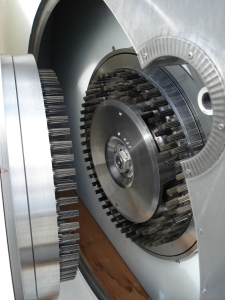Whether it is calcium carbonate in plastic applications, barite in drilling muds, or silica in rubber products, many fine powders have to be coated with certain additives to make them into functional fillers.
Since newly developed grinding and classifying processes are able to achieve finenesses which are already in the range of nanoparticle size, the coating systems face a more difficult task to efficiently de-agglomerate these ultrafine particles; overcoming the Van der Waals forces, while at the same time applying a thin layer of additives on each particle.
Calcium carbonate case study
The coating calcium carbonate with stearic acid to prepare it for certain plastic extrusion processes, provides an example to demonstrate how new technology developed by ECUTEC Barcelona SL can improve the coating process.
Having been involved in the calcium carbonate business for many years, ECUTEC was able to pinpoint key areas for optimisation when designing a new process solution.
These were:
- the need to fully de-agglomerate the ultrafine filler before applying any coating agent;
- use as little as possible of the costly coating agent;
- aim to achieve a perfect single layer of coating;
- and, to avoid creating agglomerates after the coating process.
Full de-agglomeration before application of coating agent
As a rule, the finer the particles to be coated, the bigger the Van der Waals forces acting on them will be, and the more energy is needed for de-agglomerating these particles. Typical products for such kind of coating processes are in the range of d98 = 3µm to d98 = 15µm.
The particles of such fine powders can only be separated by high shear forces, which can be generated by devices such as counter rotating pin mills. These mills contain two opposite pin discs, which run at a speed of up to 120m/s, resulting in shear velocities of about 240m/s.
Only once the particles have been separated can the coating agent can be applied; if the agent was added earlier, the agglomerates would be coated rather than the individual particles.
Using as little of the coating agent as possible
In processing technology, everything is about economics. It is therefore important not to waste costly stearic acid, but try to distribute it as efficiently as possible onto the ultrafine particles.
For different end-product finenesses, different levels of coating grades have to be used due to different surface areas. To achieve the right coating grade for each individual fineness, the massflow of calcium carbonate, as well as stearic acid, has to monitored and controlled.
ECUTEC has designed a complete Computer/programmable logic controller (PLC) loss-in-weight systems for both materials. The stearic acid is melted gently in a tank above load cells. These load cells, together with the pump and PLC, form a system where the massflow are constantly monitored and controlled.
For calcium carbonate, the hopper for the calcium carbonate powder also sits on load cells, forming, with metering systems and the PLC, another loss-in-weight system.
These two systems are combined in the PLC and certain ‘recipes’ can be created where the operator selects one desired end-product, and the plant automatically adjusts itself to the necessary feed rates of CaCO3 and stearic acid.
This technology ensures that there will not be any over-coating or waste of stearic acid, or under-coating and a loss of product quality.
Aiming to achieve a perfect single layer of coating
To successfully complete this objective of the process, the particle size of the product to be coated, which was reduced by grinding and classifying, will stay the same and only a thin layer of stearic acid needs to be applied.
ECUTEC’s preferred solution for achieving this aim is to directly inject the acid into a high speed pin mill. The injection is performed by means of an atomising nozzle, where hot pressurised air separates the melted liquid stearic acid stream into millions of small droplets.
These droplets are a minimum size of 10µm, which still is too big to achieve perfect coating of some of the ultrafine particles.
Injecting the liquid into a zone with high shear forces can reduce the size of the droplets, meaning that small particles will not get “glued” to other particles by oversized droplets.
Stearic acid should flow around each particle and build-up a thin layer on the surface, so as not to increase the particle size. Therefore it is crucial to de-agglomerate the particles and and apply the coating agent in a hot environment.
There will never be a complete coating of the whole particle, but this is not necessary. The important thing is to avoid increasing the size of the particles by coating them with too much stearic acid.
Avoid creating agglomerates after the coating process

In order to reach the final product stage, the particles must be cooled down so that the stearic acid solidifies.
With high temperatures in the ductwork for conveying the particles to the silo or bagging area, there is the risk of the particles agglomerating because the stearic acid remains sticky. In some coating systems, the full coating cannot take place in the mill and following conveying lines are kept hot to allow for some further coating activity to take place during the transport, but this comes with a high risk of agglomeration.nveying the particles to the silo or bagging area, there is the risk of the particles agglomerating because the stearic acid remains sticky.
Classifiers can be found sometimes to take out these agglomerations, but this adds to the cost of the process.
By using ECUTEC’s new coating technology, all the necessary coating can be achieved inside the mill, meaning that the particles can be transported to the silo at low temperatures, and are not at risk of agglomerating or requiring any additional processing stage.
*Joe Roettle is the Global Sales Manager for ECUTEC Barcelona SL